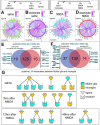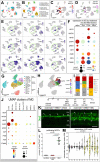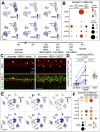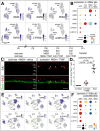Heparin-binding epidermal growth factor and fibroblast growth factor 2 rescue Müller glia-derived progenitor cell formation in microglia- and macrophage-ablated chick retinas
- PMID: 37971210
- PMCID: PMC10730090
- DOI: 10.1242/dev.202070
Heparin-binding epidermal growth factor and fibroblast growth factor 2 rescue Müller glia-derived progenitor cell formation in microglia- and macrophage-ablated chick retinas
Abstract
Recent studies have demonstrated the impact of pro-inflammatory signaling and reactive microglia/macrophages on the formation of Müller glial-derived progenitor cells (MGPCs) in the retina. In chick retina, ablation of microglia/macrophages prevents the formation of MGPCs. Analyses of single-cell RNA-sequencing chick retinal libraries revealed that quiescent and activated microglia/macrophages have a significant impact upon the transcriptomic profile of Müller glia (MG). In damaged monocyte-depleted retinas, MG fail to upregulate genes related to different cell signaling pathways, including those related to Wnt, heparin-binding epidermal growth factor (HBEGF), fibroblast growth factor (FGF) and retinoic acid receptors. Inhibition of GSK3β, to simulate Wnt signaling, failed to rescue the deficit in MGPC formation, whereas application of HBEGF or FGF2 completely rescued the formation of MGPCs in monocyte-depleted retinas. Inhibition of Smad3 or activation of retinoic acid receptors partially rescued the formation of MGPCs in monocyte-depleted retinas. We conclude that signals produced by reactive microglia/macrophages in damaged retinas stimulate MG to upregulate cell signaling through HBEGF, FGF and retinoic acid, and downregulate signaling through TGFβ/Smad3 to promote the reprogramming of MG into proliferating MGPCs.
Keywords: Cell signaling; Microglia; Müller glia; Retinal regeneration; scRNA-seq.
© 2023. Published by The Company of Biologists Ltd.
Conflict of interest statement
Competing interests The authors declare no competing or financial interests.
Figures








Similar articles
-
Regulating the formation of Müller glia-derived progenitor cells in the retina.Glia. 2025 Jan;73(1):4-24. doi: 10.1002/glia.24635. Epub 2024 Oct 24. Glia. 2025. PMID: 39448874 Free PMC article. Review.
-
Formation of Müller glia-derived progenitor cells in retinas depleted of microglia.bioRxiv [Preprint]. 2023 Jun 9:2023.06.08.544205. doi: 10.1101/2023.06.08.544205. bioRxiv. 2023. PMID: 37333380 Free PMC article. Preprint.
-
Sphingosine-1-phosphate signaling regulates the ability of Müller glia to become neurogenic, proliferating progenitor-like cells.Elife. 2025 Mar 6;13:RP102151. doi: 10.7554/eLife.102151. Elife. 2025. PMID: 40047533 Free PMC article.
-
mTor signaling is required for the formation of proliferating Müller glia-derived progenitor cells in the chick retina.Development. 2016 Jun 1;143(11):1859-73. doi: 10.1242/dev.133215. Epub 2016 Apr 11. Development. 2016. PMID: 27068108 Free PMC article.
-
A comparative analysis of Müller glia-mediated regeneration in the vertebrate retina.Exp Eye Res. 2014 Jun;123:121-30. doi: 10.1016/j.exer.2013.06.019. Epub 2013 Jul 9. Exp Eye Res. 2014. PMID: 23851023 Free PMC article. Review.
Cited by
-
Developing fibrin-based biomaterials/scaffolds in tissue engineering.Bioact Mater. 2024 Aug 15;40:597-623. doi: 10.1016/j.bioactmat.2024.08.006. eCollection 2024 Oct. Bioact Mater. 2024. PMID: 39239261 Free PMC article. Review.
-
Sphingosine-1-phosphate signaling regulates the ability of Müller glia to become neurogenic, proliferating progenitor-like cells.bioRxiv [Preprint]. 2025 Jan 24:2024.08.06.606815. doi: 10.1101/2024.08.06.606815. bioRxiv. 2025. Update in: Elife. 2025 Mar 06;13:RP102151. doi: 10.7554/eLife.102151. PMID: 39149287 Free PMC article. Updated. Preprint.
-
Regulating the formation of Müller glia-derived progenitor cells in the retina.Glia. 2025 Jan;73(1):4-24. doi: 10.1002/glia.24635. Epub 2024 Oct 24. Glia. 2025. PMID: 39448874 Free PMC article. Review.
-
Evaluating the Evidence for Neuroprotective and Axonal Regenerative Activities of Different Inflammatory Cell Types After Optic Nerve Injury.Mol Neurobiol. 2025 May;62(5):6212-6227. doi: 10.1007/s12035-024-04679-3. Epub 2024 Dec 30. Mol Neurobiol. 2025. PMID: 39738875 Free PMC article. Review.
-
Ibudilast Protects Retinal Bipolar Cells From Excitotoxic Retinal Damage and Activates the mTOR Pathway.Glia. 2025 May;73(5):905-927. doi: 10.1002/glia.24657. Epub 2025 Feb 6. Glia. 2025. PMID: 39916387 Free PMC article.
References
-
- Campbell, W. A., Deshmukh, A., Blum, S., Todd, L., Mendonca, N., Weist, J., Zent, J., Hoang, T. V., Blackshaw, S., Leight, J.et al. (2019). Matrix-metalloproteinase expression and gelatinase activity in the avian retina and their influence on Müller glia proliferation. Exp. Neurol. 320, 112984. 10.1016/j.expneurol.2019.112984 - DOI - PMC - PubMed
MeSH terms
Substances
Grants and funding
LinkOut - more resources
Full Text Sources
Molecular Biology Databases

